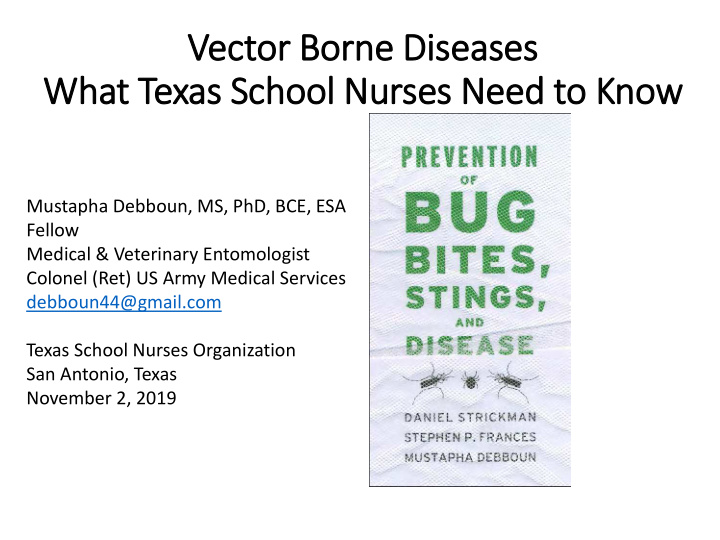



Vect ector B Borne D Disea eases What Texas S School ool N Nurses es N Need eed t to Know Mustapha Debboun, MS, PhD, BCE, ESA Fellow Medical & Veterinary Entomologist Colonel (Ret) US Army Medical Services debboun44@gmail.com Texas School Nurses Organization San Antonio, Texas November 2, 2019
Introduction
Roughl hly 3 o out of 4 4 ( (Re)Emerging ng Inf nfections ns are Ve Vector-Bo Borne ne or or Zoon oonot otic Source: AVMA and One Health Initiative
The new Texas • Has profound pockets of intense poverty (Blue Marble Health) • Poverty highest in the south along Mexico border (Colonias) • Poverty in major urban centers: Dallas and Houston • Children poverty rate >33%. Fig 1. Percentage of children in poverty ages 0 to 17 by county in Texas in 2015. Accessed at http://www.census.gov/did/www/saipe/data/statecounty/data/2015.html.
The new Texas • One of the fastest growing US states with population projected to exceed 30 million by 2020 • Contains 11 fastest growing small cities & 5 of 8 fastest growing large cities • Growth is due to immigration & economic opportunities • 3 rd among US states in % foreign- borne populations
Fig 2. Colonia Mi Sueño, Rio Grande Valley, Texas. Photo by Shaghayegh Tajvidi.
Geographic distribution of the major Texas NTDs Fig 3. Approximate geographic distribution of the major Texas NTDs. The major diseases include the vector-borne NTDs (blue) located in South Texas, Gulf Coastal Texas, North Central Texas, the Panhandle, and West Texas, as well as non-vectorborne NTDs (green) that concentrate in the three urban areas that constitute the “Texas triangle”, i.e., Dallas, Houston, and San Antonio. NCC, neurocysticercosis; WNV, West Nile virus.
Culex quinquefasciatus Primary vector of St. Louis Encephalitis (SLE) and West Nile virus (WNV) in Texas Aedes albopictus Aedes aegypti Vectors of Yellow fever, Dengue, Chikungunya, and Zika viruses … Day and Night!
Environments That Favor More Mosquitoes o Stored water and discarded containers accumulate rain water and create abundant mosquito development sites
Mosquito Breeding Sites
Mosquito Breeding Sites
Assess Screen Conditions
Malaria Worl rldwide • 3 to 4 Billion People at risk • Prevalent in tropical and subtropical areas • 300 to 500 Million Cases & 1 to 3 Million Deaths • Every 30 seconds, one person dies from Malaria
Malaria in the United States • 1,500 to 2,000 cases reported every year • Usually immigrants or travelers • “Airport Malaria” • Local Mosquito-Borne Transmission • Congenital Malaria • Transfusion Transmitted Malaria
Dengue Virus Types 1-4: Approximate Geographic Distribution
Chikungunya Virus:
OTHER VECTORS • Mosquitoes are not the only vector-borne threat • Other vectors capable of transmitting pathogens to humans in TX are: • Kissing bugs • Ticks • Sand flies, fleas, gnats, etc…
Common Ticks Found in Texas
Tick-Born rne Diseases i in Texas • Rocky Mountain Spotted Fever (RMSF) • Lyme Disease • Human Ehrlichiosis • Tularemia • Ricketsia parkeri rickettsiosis • Anaplasmosis • Babesiosis • Heartland virus disease • Southern tick-associated rash illness (STARI) • Q fever • Tick-borne relapsing fever
Kissing Bugs ( Triatoma ) • States along US-Mexico border have highest risk • Triatomine species (10 in US) • Autochthonous cases (20 since 2013 in TX) (Wozniak et al. 2015, TX DSHS) kissingbug.tamu.edu
Chagas disease in Texas • States along US-Mexico border = highest risk • 8 species of kissing bugs have been recorded in Texas • Peridomestic and sylvatic • Harris County: Triatoma sanguisgua Kjos et al (2009) • Estimated burden in US: 300,000 – 1,000,000 • Difficult to detect • 20-30% develop life- threatening symptoms Harris Bern et al County (2011)
Topical Repellents
Common Effective Repellents in the US Deet IR 3535 Picaridin PMD 2-Undecanone
Deet N,N-diethyl-3-methyl benzamide N,N-diethyl-m-toluamide • USDA & DoD Collaboration in 1940’s • Released commercially in 1956 • Broad-Spectrum • Gold Standard Repellent • Safety
Picaridin 2-(2-hydroxylethyl)-1-piperidine Carboxylic acid 1-methylpropyl ester • KBR, icaridin, bayrepel, Saltidin • Modern Efficacy & Safety Tests • Registered in over 50 countries • Excellent Effectiveness • Safe repellent
IR 3535 ethyl butylacetylaninopriopionate or EBAAP • Beta-alanine, a naturally occurring amino acid • Merck & Co. developed it by molecular modeling of other repellent compounds in 1970’s • Used in over 150 consumer products sold worldwide • US registered it in 1999 • Repels a wide variety of biting pests • Excellent against ticks • Very Safe
PMD p-menthane-3,8-diol • Major component of Chinese repellent, Quwenling which is the steam distillate from lemon eucalyptus • Effective against mosquitoes • 2005 – CDC added it to the list of repellents for use against WNV mosquito vectors • Safety: skin sensitization & eye irritation
Area or Spatial Repellents • Mosquito Coils • Electrically Heated, Butane powered mats/pads impregnated with insecticides • Candles • Chemically impregnated Curtains & Screens • Wrist-band impregnated with Deet • Deet Anklets
Example of Spatial Repellents • ThermaCELL Patio Lantern • Therma CELL Mosquito Repellent System
Example of Spatial Repellents • OFF! Powered Pad Lamp • OFF! Clip-on with metofluthrin
Example of Spatial Repellents • Mosquito Beater • Terminix ALL CLEAR Tabletop Mosquito Repellent
Arthropod Repellent Clothing • Permethrin • Impregnated Bed Nets • Insect Shield
Thank You For Listening
QUESTIONS? debboun44@gmail.com
Recommend
More recommend